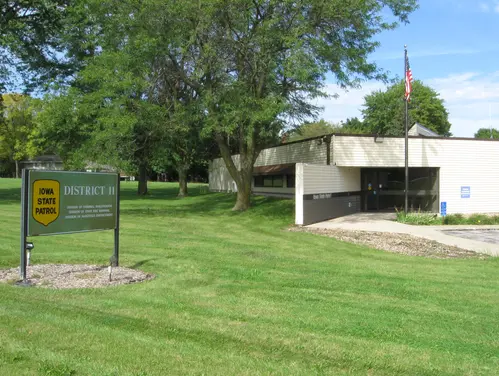Cedar Rapids has been the home of a District office since the original ten field offices were established in 1937. District 11 was originally known as District 8 and headquartered in the First Trust Building under the command of Sergeant C.B. Day. Five patrolmen were assigned to the Cedar Rapids office with three more patrolmen assigned to a substation in Tama.
District 11 is responsible for patrolling Benton, Linn, Tama, Iowa, Poweshiek, and Johnson counties.
In 1959, a new building was constructed at the junctions of Highways 30, 218, 149, and 64. In 1981, the present office was built two miles west of the old building on Highway 30. A few years later, Highway 30 was reconstructed a few miles to the south, and old Highway 30 is now 16th Avenue SW in Cedar Rapids.
The current facility also houses Iowa State Patrol Communications, Division of Criminal Investigation (DCI), Division of Narcotics Enforcement (DNE), and State Fire Marshal's Office (SFM).
District 11 assists with the University of Iowa football games, has hosted six Farm Progress Shows, and is home to the historic Amana Colonies. District 11 is also the forward command post for Iowa’s only nuclear power facility. It serves a population of 415,000 and encompasses over 3,900 square miles. There are over 6,900 miles of roadway, including 125 miles of interstate. Interstate 80 crosses the southern portion of District 11 and is patrolled 24 hours a day. Interstate 380 and Highway 218 run north through Iowa City and Cedar Rapids and is referred to as the “Avenue of the Saints".
During the flood of 1993, the Iowa State Patrol supported extensive traffic control duties to re-route traffic when Interstate 380 was shut-down for several days. On June 13, 2008, the Cedar River crested to its highest level in Cedar Rapids history, 31.12 feet. The flood waters penetrated ten square miles or 14 percent of the city, displacing 18,000 residents and necessitated the evacuation of the entire town of Palo. The police, sheriff, and city government buildings were displaced and the Linn County Jail had to be evacuated, which required troopers to provide security and escort. Interstate 380, as well as all major highway routes in the area, were impassible. The flood also impacted Iowa City and some of the University of Iowa campus facilities. The flood required a statewide response of troopers providing 24-hour support for traffic control and law enforcement presence in Cedar Rapids and Palo.
Iowa State Patrol District #11
5400 16th Avenue SW
Cedar Rapids IA 52404
319.396.1944
